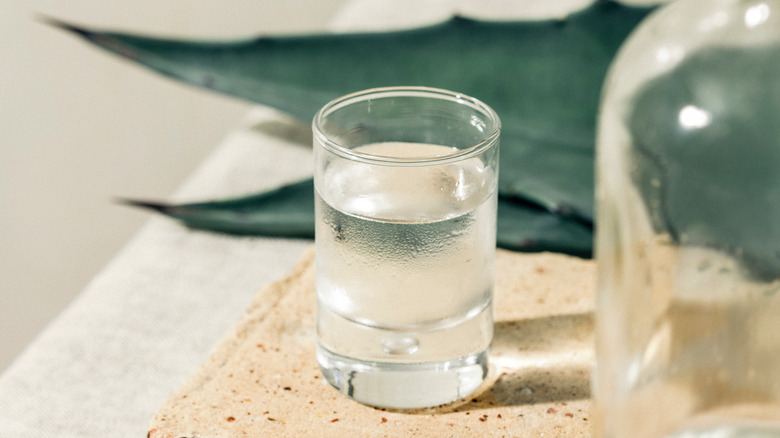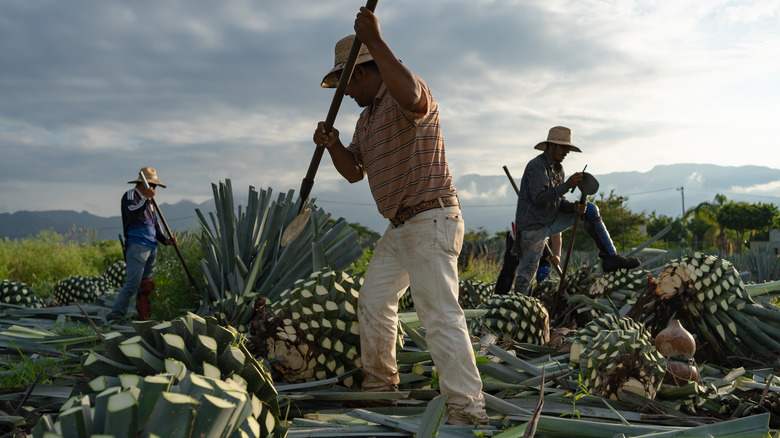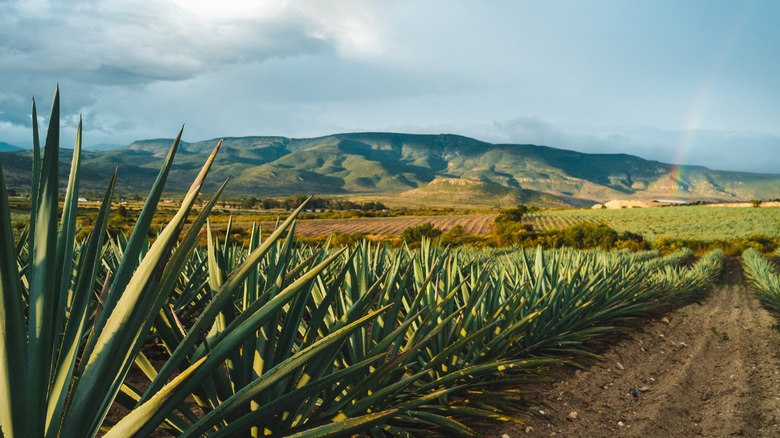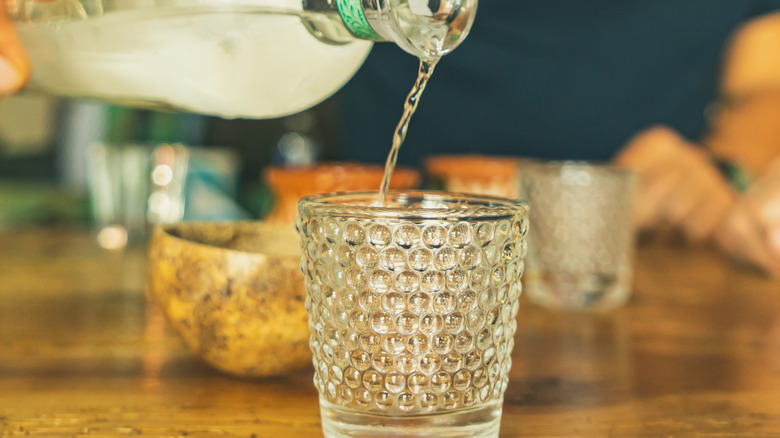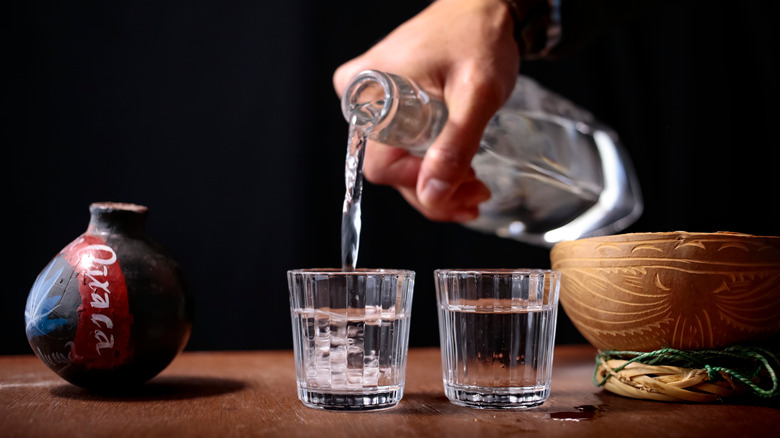Meet Bacanora, The Middle Man Between Tequila And Mezcal
If you're a spirits fan, you're already well-acquainted with tequila and mezcal. But what about bacanora? Simply put, bacanora is the midway point between these two spirits, and if you haven't been drinking bacanora, it might be time to rethink your cocktail game.
Bacanora, mezcal, and tequila are all made from agave plants. But, in order for a spirit to be considered "tequila," it must be made from the blue weber agave plant. In the same way, bacanora is made from Yaquiana or Pacifica agave plants, aka agave angustifolia, and like tequila, no sweeteners or additives are allowed.
Mezcal can be made from any type of agave. Most often, bacanora is made from hand-harvested agave plants that grow in the wild. Why? Industrial, controlled agave farms are typically already taken up by plants used for making tequila and mezcal. As a result, bacanora is for foragers.
Just like tequila must be grown in Guanajuato, Jalisco, Michoacan, Nayarit, or Tamaulipas, bacanora is exclusively made from agave plants grown in the Northwestern Mexican state of Sonora. In fact, Bacanora is named after the eponymous Sonoran city and has remained an integral piece of Bacanoran and Sonoran history and culture since its conception and decidedly rocky adolescence.
Bacanora came back for more
While Prohibition was rocking American spirits fans during the 1900s, bacanora was enduring a prohibition all its own several hundred miles south. In 1915, Plutarco Elías Calles, then-governor of Sonora, outlawed bacanora under the penalty of hanging due to his own religious beliefs. Because it was a type of alcohol, argued Calles, bacanora could only lead to raucous behavior and downright no-good — which actually couldn't have been further from the case. Bacanora was the go-to libation for personal celebrations and family affairs, like quinceañeras, weddings, and holidays. In short, when you wanted to party, you were probably reaching for tequila or mezcal before you thought of bacanora.
Whether due to conservatism or simple legislative neglect, the spirit didn't become legal again until 1992, nearly a century later. The only reason why folks know how to make bacanora at all today is thanks to the few diehard fans who braved the threat of penalties and made the spirit on the down-low during the ban (not too dissimilar from American moonshiners).
How bacanora is made
Other than its specific region of origin, what really makes bacanora special is its hands-on production process. Sonoran distillers have been making bacanora for around 300 years — which, considering records of Scottish whiskey-making date back to 1494, makes bacanora a fairly young spirit. Still, over the course of those 300 years, not much has changed in the way bacanora is made: handcrafted in small batches.
Technically speaking, bacanora is a type of mezcal. Tequila is aged into different classes (blanco, reposado, añejo, and extra añejo) with different colors and flavors. Conversely, like mezcal, bacanora's flavor comes from roasting during production. To make it, Pacifica agave plants are harvested between six and eight years old and roasted over wood and charcoal.
After roasting, the agave is manually ground into a pulp either by hand with mallets or using a large stone wheel turned by a donkey. When attention to detail counts, look no further than to bacanora. From there, the pulled agave gets left to ferment for six to 12 days before being distilled twice and diluted into the finished spirit. It's a two-week-long process in total and well worth the labor of love.
Taste the action for yourself
What does bacanora taste like, anyway? It's stronger and smokier than tequila but more accessible than harsh mezcal. In the same way that wine grapes grown in Bordeaux taste different from those grown in Naples, bacanora's flavor profile is heavily influenced by Sonora's hot climate and dry soil conditions, lending an earthy, mineral-forward, vegetal taste. Some tasters detect notes of roasted coffee and leather. Pacifica agave plants grown closer to the coastline can even tote more delicate notes of citric, tangy ocean winds.
Due to its complex profile and standard ABV of 40%-50%, bacanora is most often sipped straight-up or neat or downed as a shot. But, it could also be used in place of gin in a Martinez. Intrepid mixologists might even use it to spike a favorite mixer and dream up a cocktail all their own. Pineapple juice would work well, and to bring out the earthier, spicy notes, try pairing it with steeped black tea.
Where to buy bacanora
To track down a bottle and taste the (once) forbidden fruit for yourself, pop over to your local liquor store and look through the tequila-mezcal section. Bacanora should be dwelling somewhere thereabouts. However, if your go-to spirits shop doesn't keep bacanora in stock, there are plenty of online spirits purveyors that'll help make the job easy.
As with any spirit, different bacanoras are available at varying price points. In general, the longer a bacanora is aged, the higher the price point. A 750-milliliter bottle of Rancho Tepua Blanco runs from $61.99 on Total Wine. A matured offering like Vinateros Bacanora Reserva will set you back $79.99 on Drizly.
For luxury spirits fans, the Aniversario Fernando Robles by Aguamiel is a beautifully aged bacanora that costs over $650 via La Cubiella. Sunora makes one of the best quality affordable bacanoras on the market, and it's distributed internationally for fans around the world to enjoy. For its traditional roasting and distillation practices, Sunora's 100% agave Blanco bacanora won Double Gold at the San Francisco World Spirits Competition in 2019 — and a full-sized bottle runs in the area of $45.
